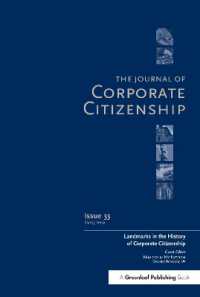- ホーム
- > 洋書
- > 英文書
- > Science / Mathematics
Full Description
Eco-efficient Construction and Building Materials reviews ways of assessing the environmental impact of construction and building materials. Part one discusses the application of life cycle assessment (LCA) methodology to building materials as well as eco-labeling. Part two includes case studies showing the application of LCA methodology to different types of building material, from cement and concrete to wood and adhesives used in building. Part three includes case studies applying LCA methodology to particular structures and components.
Contents
Contributor contact details
Woodhead Publishing Series in Civil and Structural Engineering
1: Introduction to the environmental impact of construction and building materials
Abstract
1.1 Introduction
1.2 Environmental impact assessment
1.3 The European Construction Products Regulation (CPR)
1.4 Outline of the book
Part I: Life cycle assessment (LCA), eco-labelling and procurement
2: Mineral resource depletion assessment
Abstract
2.1 Introduction
2.2 Definition and classification of mineral resources
2.3 Trends in mineral use and depletion
2.4 Dynamic analysis of mineral resource use and depletion: the Hubbert peak model
2.5 From grave to cradle: A new approach to assess and account for mineral depletion
2.6 Conclusions
3: Life cycle assessment (LCA) of sustainable building materials: an overview
Abstract
3.1 Introduction
3.2 The environmental impact of building materials
3.3 Life cycle assessment (LCA) and sustainable building materials
3.4 Conclusions
4: Life cycle assessment (LCA) of the building sector: strengths and weaknesses
Abstract
4.1 Introduction
4.2 The overall strengths and limitations of life cycle assessment (LCA)
4.3 Strengths and weaknesses within LCA methodology
4.4 Conclusions
5: Using life cycle assessment (LCA) methodology to develop eco-labels for construction and building materials
Abstract
5.1 Introduction: life cycle thinking and eco-labels
5.2 Life cycle assessment (LCA)
5.3 Types of eco-labels and their relation to LCA
5.4 Environmental certification programmes for buildings
5.5 Future trends
5.6 Sources of further information and advice
6: The EU Ecolabel scheme and its application to construction and building materials
Abstract
6.1 Introduction
6.2 The EU Ecolabel and the European Commission policy for sustainability
6.3 History and goals of the EU Ecolabel scheme
6.4 EU Ecolabel establishment procedures and criteria
6.5 EU Ecolabel and green public procurement (GPP)
6.6 EU Ecolabel and national ecolabelling schemes
6.7 EU Ecolabel for eco-efficient construction and building materials
6.8 Future trends
6.9 Sources of further information and advice
6.11 Appendix: abbreviations
7: Environmental product declaration (EPD) labelling of construction and building materials
Abstract
7.1 Introduction
7.2 Regulatory framework
7.3 Objectives and general principles
7.4 Environmental product declaration (EPD) methodology
7.5 EPD programmes around the world
7.6 Product category rules (PCR) for construction and building materials
7.7 Case studies: EPD for construction and building materials
7.8 Conclusions
8: Shortcomings of eco-labelling of construction and building materials
Abstract
8.1 Introduction
8.2 Typical shortcomings of eco-labels
8.3 Building materials
8.4 Eco-labelling of buildings
8.5 Conclusions
9: Green public procurement (GPP) of construction and building materials
Abstract
9.1 Introduction
9.2 Green public procurement (GPP) and sustainable public procurement (SPP) as policy instruments
9.3 Policy context in the EU
9.4 Policy context in selected countries
9.5 The need for a paradigm shift
9.6 Implementing GPP/SPP in the construction sector
9.7 Key concerns for progress towards SPP
Part II: Assessing the environmental impact of construction and building materials
10: Assessing the environmental impact of conventional and 'green' cement production
Abstract
10.1 Introduction
10.2 Environmental impact of ordinary Portland cement
10.3 Supplementary cementitious materials (SCMs)
10.4 Alternative binders
10.5 Balancing function and environmental impact
10.6 Conclusions and future trends
11: Life cycle assessment (LCA) of concrete made using recycled concrete or natural aggregates
Abstract
11.1 Introduction
11.2 Life cycle assessment (LCA) of recycled aggregate concrete (RAC)
11.3 Influence of different phases in the production process for natural and recycled concrete
11.4 Research on the use of natural and recycled aggregates in concrete
11.5 Analysis of the influence of the transport phase
11.6 Analysis of the influence of CO2 uptake during the life cycle of concrete
11.7 Conclusions and future trends
11.8 Acknowledgement
12: Life cycle assessment (LCA) of building thermal insulation materials
Abstract
12.1 Introduction
12.2 Thermal insulation materials and their properties
12.3 Life cycle assessment (LCA) analysis of thermal insulation materials
12.4 The ecological benefits of thermal insulation of external walls of buildings
12.5 The economic benefits of thermal insulation
12.6 Conclusions
13: Life cycle assessment (LCA) of phase change materials (PCMs) used in buildings
Abstract
13.1 Introduction to phase change materials (PCMs) and their use in buildings
13.2 Investigating the use of PCMs in buildings
13.3 Life cycle assessment (LCA) methodology
13.4 PCM impact and selection
13.5 LCA of buildings including PCMs: case studies
13.6 Improvement in PCM use
13.7 Problems in undertaking an LCA of buildings including PCMs
14: Life cycle assessment (LCA) of wood-based building materials
Abstract
14.1 Introduction
14.2 Forestry and wood production
14.3 Wood product manufacture
14.4 Building with wood materials
14.5 Integrated energy and material flows
14.6 Wood products and climate change
14.7 Wood building materials: past and future
14.8 Sources of further information
14.9 Acknowledgement
15: The environmental impact of adhesives
Abstract
15.1 Introduction: growth in the usage of adhesives
15.2 Environmental implications of the growth in adhesive use
15.3 Adhesives, adhesion and the environment
15.4 Reduction of environmental impact
15.5 A technical 'fix' for the environmental crisis
15.6 Energy demand and supply
15.7 The stationary state: limits to growth
15.8 Conclusions and future trends
15.9 Acknowledgement
16: Life cycle assessment (LCA) of road pavement materials
Abstract
16.1 Introduction
16.2 Life cycle assessment (LCA) for roads
16.3 LCA for motorway construction
16.4 LCA for motorway use and maintenance
16.5 LCA for the demolition/deconstruction of motorways
16.6 Conclusions and future trends
16.7 Acknowledgements
16.9 Appendix: abbreviations
Part III: Assessing the environmental impact of particular types of structure
17: Comparing the environmental impact of reinforced concrete and wooden structures
Abstract
17.1 Introduction
17.2 Environmental strengths and weaknesses of using wood and concrete in construction
17.3 Life cycle assessment (LCA) for wood and concrete building design
17.4 Using LCA to compare concrete and wood construction: a case study
17.5 Selection and adaptation of LCA tools
17.6 Life cycle impact assessment and interpretation
17.7 Future trends
17.8 Sources of further information and advice
18: Assessing the sustainability of prefabricated buildings
Abstract
18.1 Introduction
18.2 A brief history of prefabricated buildings
18.3 Types of prefabrication technologies
18.4 Assessing prefabricated buildings
18.5 Case study: sustainability assessment of prefabricated school buildings
18.6 Conclusions, recommendations and future trends
18.7 Sources of further information and advice
18.8 Acknowledgments
19: Life cycle assessment (LCA) of green façades and living wall systems
Abstract
19.1 Introduction
19.2 Life cycle assessment (LCA) methodology
19.3 Interpretation and analysis of LCA results
19.4 Interpretation of the LCA analysis
19.5 Conclusions
19.6 Acknowledgements
20: Assessing the environmental and economic impacts of cladding systems for green buildings
Abstract
20.1 Introduction
20.2 The need for green buildings
20.3 The role of cladding systems in making buildings green
20.4 Implementation: assessing the eco-efficiency of cladding systems in Bahrain
20.5 Interpretation and conclusions
21: Life cycle assessment (LCA) of windows and window materials
Abstract
21.1 Introduction
21.2 Modern window construction
21.3 The life cycle of a window
21.4 Previous window life cycle assessment (LCA) studies
21.5 The influence of timing on the results of window LCA
21.6 Use of advanced technology
21.7 Selection of environmentally friendly window materials
21.8 Current developments and future trends
22: Life cycle assessment (LCA) of ultra high performance concrete (UHPC) structures
Abstract
22.1 Introduction
22.2 Life cycle assessment (LCA) data and impact assessment method
22.3 Impact assessment of raw materials used in ultra high performance concrete (UHPC)
22.4 Impact assessment of UHPC at material level
22.5 Impact assessment of structures made with UHPC
22.6 Cost of UHPC
22.7 Conclusions and future trends
23: Life cycle assessment (LCA) of fibre reinforced polymer (FRP) composites in civil applications
Abstract
23.1 Introduction
23.2 Life cycle assessment (LCA) method
23.3 LCA of fibre reinforced polymer (FRP) composites: case studies
Results and discussion
Results
23.4 Summary and conclusions
Index








